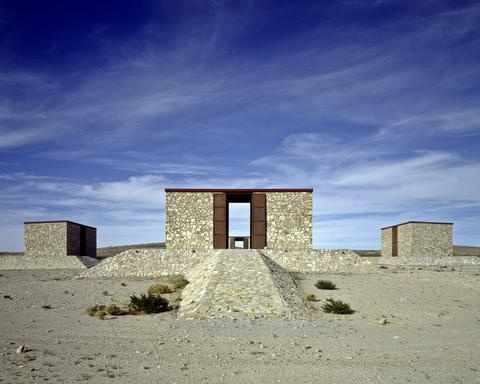For more than a quarter of a century, the American artist, James Magee, has been engaged in a massive, largely secret, almost solitary endeavor in the vast plains of West Texas. A Michigan-born, Ivy League-educated lawyer, Magee’s unusual trajectory through New York taxi driver and off-shore roughneck led him to make his home in El Paso, Texas, a border city made up of equal parts Mexico and the U.S., where, fittingly, he produces a vast body of work both under his own name and under the names of Annabel Livermore and Horace Mayfield, liminal identities in a liminal place. A painter, sculptor, poet, film and video maker, widely featured in museum and gallery exhibitions across the U.S. from the Yale University Art Gallery to the Santa Monica Art Museum, Magee here reveals himself to be an architect, engineer and builder as well.
On 2000 acres of desert land in Cornudas, 70 miles east of El Paso, James Magee has designed and built four identical buildings connected by causeways. A complex and monumental work of art, what is known as The Hill consists of these buildings, each 40 feet long, 20 feet wide and an impressive 17 feet in height, three of which have installations made by Magee. The buildings are expertly crafted of irregularly-cut shale rock of which nearly 250 eight-ton truckloads were brought to the site. Each of the buildings is entered through a majestic iron portal, 8 feet wide and the full height of the building, portals that turn easily on their hinges, testament to the remarkable engineering acumen Magee has brought to the project as a whole. Decades in the making, a product of one man’s infinite patience and unimaginable labor, The Hill sits in a gently rolling landscape with mesmerizing views of snow-capped mountains and limitless West Texas skies.
The buildings of The Hill — sited in a cruciform plan with their doors facing each other — sit on a promontory rising above the rocky desert. From door to door, the buildings are 187 feet apart, and the entire complex takes up 52,000 square feet. They rise above retaining walls fashioned of the same stone as the buildings, and are connected by means of stone paths of a generous width. The sight of The Hill, so elegantly fabricated, classically-proportioned and mysteriously-sited amidst rocky desert and sky, inspires awe, even a sense of the sacred, well before the viewer enters a building.
To visit the complex, the vast double doors of each building must be opened, a task that is by no means trivial. Moreover, each of the three completed buildings house enormous metal installations that themselves open into a materially and visually complex gesamtkunstwerk. On occasion, while visitors take the considerable time required to study the works, Magee will recite their “titles”— in effect, lengthy poetic texts, at once allusive and immediate.
The installations themselves are large, metal-framed and glazed, hinged together in metal boxes like the wings of an Iron Age altar. Fashioned of a great variety of materials, such as cinnamon, paprika, flower petals, oil, wood, metal, rust, paint, textiles and more — the boxes resonate with the harsh beauty of their site. As these large panels are opened and moved to reveal yet other large boxes, they evoke a sense of endless complexity, belying their creation by one man. Shifting and moving with the scale and power of the natural, they are also utterly artificial, completely abstract creations, analogs of the uneasy coexistence of the natural and the human in these remote plains. Less artworks in the usual sense than immense environments, The Hill is like a chapel filled with inexplicable altars belonging to some unknown religion.
The Hill is a profoundly original work of art; nothing like it exists anywhere else. Of the land, but not land art, sculptural but not sculpture, its closest analogs are the relief-adorned temples of southern India or Mesoamerica, and it is as isolated, improbable, and mysterious as they. Solemn, weighty, even ponderous, The Hill transmutes materiality into spirit and, despite its many tons of geared esthetic machinery, seems more ethereal and dreamlike than metal and stone. A site of national and even international stature, The Hill is the life’s work — and crowning achievement — of James Magee.
